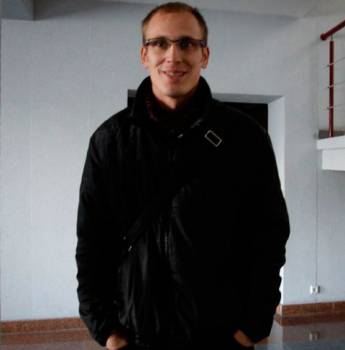Analytical review of the court proceedings on the criminal case of Sviataslau Baranovich
The hearings on the criminal case were held at the
Maskouski District Court of Minsk since 28 September till 12 October. The trial
was led by Judge Alena Rudnitskaya with the participation of prosecutor of the
Maskouski District Procuracy of Minsk Siarkou as the state accuser.
Mr. Baranovich was charged under Article 293, part 2 of the Criminal Code of
the Republic of Belarus,
“direct participation in mass riot” for participation in the peaceful protest
rally on 19 December 2010 in
Minsk.
On 12 October the court found Baranovich guilty and sentenced him to three
years of personal restraint without direction to a penitentiary institution.
The court used Article 70 of the Criminal Court towards Sviataslau Baranovich
and gave him a penalty which was milder than the minimal sanction of Article
293, part 2 of the Criminal Code. This was done with reference to mitigating
circumstances: that Sviataslau Baranovich was young and had a job.
Despite the fact that the verdict seems to be mild, the Human Rights Center
“Viasna” thinks that it doesn't correspond to the factual materials of the case
and therefore is unlawful.
1. Likewise with the previous trials, there was no evidence that mass riot took
place during the peaceful action of protest on 19 December 2010 in Minsk. According to Article 293, part 2 mass
riot is accompanied with arsons, pogroms, personal violence, destruction of
property and armed resistance to law-machinery officers and public agents.
2. No evidence was provided at court that the defendants committed at least one
of the actions which are qualified as committing mass riot by the disposition
of Article 293 of the Criminal Code of the Republic of Belarus.
3. A number of court materials, first of all – video materials, can directly
prove that Baranovich committed other violations of the law, which can be
qualified as disorderly conduct.
During his speech at the court debates the state accuser didn't give any
assessment to testimonies of numerous victims, namely Siarhei Masalski, Siarhei
Palai, Dzmitry Shpak and Vadzim Smirnou, who said they hadn't seen the
defendant or other demonstrators delivering blows, making pogroms, arsons or
showing armed resistance to the police. The only thing the state accusation was
referred to was that the commitment of mass riot on 19 December 2010 had been
proved during analogical trials. Thus, nether the state accuser, nor the court
gave an assessment to testimonies of the victims and the defendant's witnesses,
from which it followed that there had been no mass riot in Minsk.
Absence of the fact of mass riot
The protect action of 19 December 2010 in Minsk
was of peaceful in its essence. Only a small group, not more than 20 people,
deviated from the peaceful character of the action and took part in violent
actions. Some of them wade it from hooligan motives, but their activities
weren't accompanied with pogroms, arsons, armed resistance and personal
violence.
Mass riot provides a direct intent, coordination of actions and wildness of the
crowd. The witnesses stated they hadn't seen the demonstrators holding any times
which could be used for violent actions (including spade handles, ice axes,
spades and axes). Unlawful actions were stopped as soon as the riot police
came, which had demonstratively abstained from interfering with actions of
lawbreakers for quite a long time.
Evidence of guilt
None of the witnesses confirmed seeing the defendant hitting police
officers or the entrance door of the House of the Government. The defendant
explained that he was hit in the head with a truncheon. Being in a state of
shock and bleeding, he delivered several blows on the police baffles with a
truncheon he had pulled out of a window of the House of the Government, but
didn't intend to beat the police or inflict any harm to them.
Conclusion
The conviction of Sviataslau Baranovich under Article 293, part 2 of the
Criminal Code of the Republic
of Belarus is unlawful
and politically motivated.
Short description of the trial
28 September 2011
The trial started with reading of the accusation by the prosecutor, from which
it followed that Sviataslau Baranovich had taken an active part in a mass riot
which was accompanied with arsons, personal violence and resistance to public
agents, that he had allegedly joined several thousand of people under the
pretext of the non-democratic character of the presidential election.
Baranovich acted in a mob, using physical violence.
Baranovich partially admitted his guilt and explained to the court that he went
up the stairs of the House of the Government on Nezalezhnasts Square and was hit in the
head with a truncheon. He surrendered to his emotion and wanted to break
through, but didn't want to inflict any harm to anybody. He snatched a
truncheon out of a policeman's hands and picked a baffle which was lying
nearby, after which he walked further into the crowd. He delivered blows with
his hands and the truncheon only on the baffles, to prevent the police from
beating people next time. He explained his actions with a nervous breakdown and
the fact that the police started beating peaceful citizens, including him.
The court proceeded to interrogation of witnesses. Witnesses Perapeika,
Skarakhod, Strahach, Zinkevich and others didn't see any arsons, but saw a
crowd with different level of aggression, which attacked police officers. All
witnesses emphasized that they hadn't seen the accused and couldn't tell
anything about his actions.
12 October 2011
The hearings started with interrogation of victims Ihar Bahnou, Andrei
Liavitski, Vadzim Smirnou and others, who gave analogical testimonies, i.e. they
hadn't seen the defendant. They also stated that they hadn't seen any traits of
mass riot, through sticks had been thrown into them and they had been hit with
plastic fishing rods that hadn't inflicted any harm to them.
The court proceeded to familiarization with written materials of the case.
The main document was the protocol of examination of the scene. According to
it, bottles, iron bars, spade handles, an axe, ice axes, bottles with
incendiary mix and other tools were found there.
A video of the events was watched by the judge with the sound turned off. The
present people weren't shown the video. After watching the video, the counsel
emphasized that the defendant hadn't hit on the baffles and hadn't tried to get
into the window of the House of the Government.
There were no debates.
The prosecutor made a short remark on the fact of mass riot, referring to
earlier court verdicts, and then proposed to use Article 70 of the Criminal
Code and started speaking about the mitigating circumstances which could be
used to give the defendant a sentence which would be milder than the minimal
sanction of the accusative article.
The counsel agreed that the fact of mass riot had been proved during other
trials, but emphasized that there hadn't been any mass riot and asked to
justify his client.
the court agreed with the prosecutor's arguments and issued a penalty which was
not connected to imprisonment.
Such verdict again emphasizes the political character of all trials connected
to the events of 19 December 2010, as far as earlier sentences, issued for
actions which were by far less aggressive than that of Baranovich, were
connected with imprisonment, which witnesses that the real aim of the
authorities was to use repressions towards political activists and participants
of the protest action. What concerns the situation of Sviataslau Baranovich,
the authorities wanted to demonstrate the decrease of the number of political
prisoners for increasing the opportunities for negotiations with the European
Union.


















